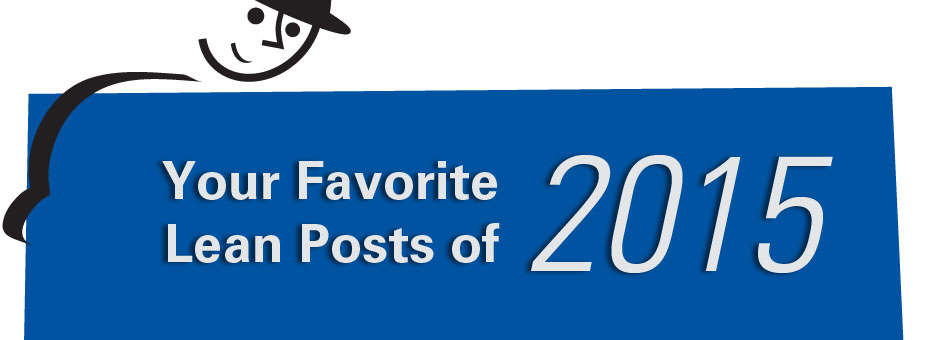With 2016 fast approaching, we’d like to take a step back and reflect on the most popular Lean Post articles of 2015. Congratulations and gratitude to all of our contributors, and a huge thank you to all of our readers as well for your invaluable comments, feedback and loyalty throughout the year. See if any of your favorites made the list, and here’s to another successful year of The Lean Post!
1. Too Busy to Improve, by Mike Orzen
“The number of people I meet who tell me, ‘I don’t have time to make improvements to my work,’ amazes me,” writes Mike Orzen. But staying under water, always behind on work, doesn’t work either. Learn more about how to think differently about overwhelm and get ahead of the game.
2. 10 Tips for Getting the Most Value from Value Stream Mapping, by Judy Worth
Most people see only a small amount of what is to be gained from value stream mapping. “Such an exercise can be a powerful organizational development tool,” says Judy Worth, “as well as one for improving value stream performance on quality, efficiency, and safety.” Before you embark, keep these 10 key things in mind.
3. Why Practicing Lean Thinking Matters (Even if Your Bosses Don’t Care), by Michael Balle
“If your boss doesn’t get [lean thinking], don’t expect to convince him/her,” writes Michael Ballé. “Do expect to get him/her interested if you manage to make them look good with your results.” And no matter what, Ballé says, never underestimate the importance of your local lean efforts.
4. Why Meaningful Improvement Requires a “Growth Mindset,” by Katrina Appell
Ever feel frustrated, constricted, or powerless to do the right thing in your organization? Katrina Appell says it all has to do with whether or not we work in an “enabling” bureaucracy or “coercive” one.
5. Personal Kanban: You Can’t Manage What You Can’t See, by David Drickhamer
Think personal kanban can’t be applied to knowledge work? Think again. Drawing on examples from Jim Benson and Tonianne DeMaria Berry’s book “Personal Kanban: Mapping Work, Navigating Life,” David Drickhamer explains how anyone can benefit from personal kanban, regardless of the nature of their work.
6. 5 Ways to Help Every Team Member Contribute Ideas for Improving Work, by Daniel Fleming
“Engaging staff in problem identification and suggestions for improvement is essential for any organization,” writes Dan Fleming, Continuous Improvement Manager at GBMP (Greater Boston Manufacturing Partnership). “Yet most organizations don’t have a system that effectively encourages staff involvement.” Learn how to create such a system with this short, helpful post.
7. Value Stream Maps and Battle Plans – Are They Worth Nothing? by Chet Marchwinski and Judy Worth
“I’m reluctant to say maps are nothing, but there’s a difference between maps and mapping,” Judy Worth says, paraphrasing Eisenhower’s insight that battle plans meant nothing, but PLANNING for battle was indispensable. “An awful lot of lot of the benefit that comes out of value-stream maps comes from the process of mapping with other people.”
8. The Secrets of Lean, by Dr. John R. Ehrenfeld and Tom Ehrenfeld
“The key to Lean is that it creates understanding, not knowledge,” write John Ehrenfeld (Executive Director of the International Society for Industrial Ecology) and LEI Senior Editor Tom Ehrenfeld. “One difficulty in successful implementation of lean systems is that managers conflate these two important concepts.” Read more.
9. Why Effective Problem Solving Begins with a Good Problem Statement, by Dave LaHote
“Let’s solve world peace” or “let’s state our predetermined solution as a problem” aren’t real problem statements, says Dave LaHote. Read why a good problem statement is so important, why it’s harder than you think to come up with one, and learn how to write a better one.
10. People Don’t Fail, Processes Do, by Terry Smith
Terry Smith, a lean web developer, shares two examples of real-life companies that used the “5 Whys” to drill down to the root of a thorny problem.
